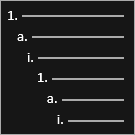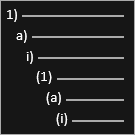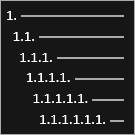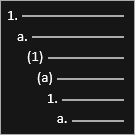Importing Plain Text (.txt) Files
Import Plain Text (.txt) Files into Innoslate through the Import Analyzer.
The Import Analyzer consists of three essential steps that users follow to configure their Plain Text (.txt) import and accurately map to their data Innoslate project's schema.
- Configure Settings
- Importing a Plain Text (.txt) File
- Preview of Import
In the subsequent sections, we will provide a comprehensive breakdown of each step outlined above, accompanied by precise instructions to facilitate your understanding of the process.
Configure Settings
1. Open the ‘Import Analyzer‘ and select the ‘Plain Text (.txt)’ tab.

2. Enter a name for your new document artifact.

Figure 2: Configure Settings .txt Import Analyzer
3. Enter Name for New Document Artifact.
4. Select the Document Type you'd like the analyzer to use. Selections are None, Document, Test Suite, Compilation, Presentation.
4a. Choose a Document Label if you selected a Document in Step 4.
5. Select the default class you'd like the analyzer to use.
6. Select which outline format matches your text.
7. To continue to Step 2, simply click the ‘Next’ button located at the top right corner of the Analyzer.
Importing a Plain Text (.txt) File
8. You can either upload your .txt file directly or paste your text into the text editor.

Figure 3: Configure Settings .txt Import Analyzer
9. Click the ‘Next’ button to proceed to Step 3.
Preview of Import
10. Verify that the preview of the data satisfies your requirements. To finish the import process and save the entities to your current project’s database, click the ‘Save’ button. To go back, modify your text and try importing again, click the ‘< Prev’ button to return to the previous step in the process.

Supported Formats
Simple List Formats
A simple list is an ordered collection of elements. There is no hierarchical data associated with this list, and all elements will be at the same level. Common uses for these lists include: a list of parts, a list of tasks/actions, or a list of locations.
Number with Period
 A list of numbers with end periods.
A list of numbers with end periods.
Example:
1. Maximum Speed
The system shall be able to achieve a speed of 120 mph.
2. Acceleration
The system shall be able to accelerate from 0 mph to 60 mph in 8 seconds.
3. Development Time
The total development time shall be less than or equal to 3 years.
Number with End Parentheses
 A list of numbers with end parentheses.
A list of numbers with end parentheses.
Example:
1) Maximum Speed
The system shall be able to achieve a speed of 120 mph.
2) Acceleration
The system shall be able to accelerate from 0 mph to 60 mph in 8 seconds.
3) Development Time
The total development time shall be less than or equal to 3 years.
Uppercase Roman Numeral with Period
 A list of roman numerals with end periods.
A list of roman numerals with end periods.
Example:
I. Maximum Speed
The system shall be able to achieve a speed of 120 mph.
II. Acceleration
The system shall be able to accelerate from 0 mph to 60 mph in 8 seconds.
III. Development Time
The total development time shall be less than or equal to 3 years.
Uppercase Alpha with Period
 A list of uppercase alphas with end periods.
A list of uppercase alphas with end periods.
Example:
A. Maximum Speed
The system shall be able to achieve a speed of 120 mph.
B. Acceleration
The system shall be able to accelerate from 0 mph to 60 mph in 8 seconds.
C. Development Time
The total development time shall be less than or equal to 3 years.
Lowercase Alpha with End Parentheses
 A list of lowercase alphas with end parentheses.
A list of lowercase alphas with end parentheses.
Example:
a) Maximum Speed
The system shall be able to achieve a speed of 120 mph.
b) Acceleration
The system shall be able to accelerate from 0 mph to 60 mph in 8 seconds.
c) Development Time
The total development time shall be less than or equal to 3 years.
Lowercase Alpha with Period
 A list of lowercase alphas with end periods.
A list of lowercase alphas with end periods.
Example:
a. Maximum Speed
The system shall be able to achieve a speed of 120 mph.
b. Acceleration
The system shall be able to accelerate from 0 mph to 60 mph in 8 seconds.
c. Development Time
The total development time shall be less than or equal to 3 years.
Lowercase Roman Numeral with Period
 A list of lowercase roman numerals with end periods.
A list of lowercase roman numerals with end periods.
Example:
i. Maximum Speed
The system shall be able to achieve a speed of 120 mph.
ii. Acceleration
The system shall be able to accelerate from 0 mph to 60 mph in 8 seconds.
iii. Development Time
The total development time shall be less than or equal to 3 years.
Number without Period
 A list of numbers.
A list of numbers.
Example:
1 Maximum Speed
The system shall be able to achieve a speed of 120 mph.
2 Acceleration
The system shall be able to accelerate from 0 mph to 60 mph in 8 seconds.
3 Development Time
The total development time shall be less than or equal to 3 years.
Supported Multi-Level List Formats
A multi-level list is a hierarchically ordered collection of elements. Hierarchical data is driven by the number, such that level 2 numbers are a child of level 1 numbers. Common uses for these lists include: a requirements document, organization’s hierarchy, or system components.
Multi-Level List with Periods
The outline for this multi-level list is:
1st Level: Number with an end period.
2nd Level: Lowercase alpha with an end period.
3rd Level: Lowercase roman numeral with an end period.
4th Level: Number with an end period.
5th Level: Lowercase alpha with an end period.
6th Level: Lower case roman numeral with an end period.
Example Input:
1. System Requirements
a. Performance Requirements
i. Maximum Speed
The system shall be able to achieve a speed of 120 mph.
ii. Acceleration
The system shall be able to accelerate from 0 mph to 60 mph in 8 seconds.
b. Cost Requirements
i. Manufacturing Costs
Total manufacturing costs shall be less than $40.
ii. Lifecycle Costs
The average yearly lifecycle cost shall be less than or equal to $1,000.
c. Schedule Requirements
i. Development Time
The total development time shall be less than or equal to 3 years.
ii. Manufacturing Time
The total manufacturing time shall be less than or equal to 10 days.
Multi-Level List with Parentheses
The outline for this multi-level list is:
1st Level: Number with an end parentheses.
2nd Level: Lowercase alpha with an end parentheses.
3rd Level: Lowercase roman numeral with an end parentheses.
4th Level: Number in parentheses.
5th Level: Lowercase alpha in parentheses.
6th Level: Lower case roman numeral in parentheses.
Example Input:
1) System Requirements
a) Performance Requirements
i) Maximum Speed
The system shall be able to achieve a speed of 120 mph.
ii) Acceleration
The system shall be able to accelerate from 0 mph to 60 mph in 8 seconds.
b) Cost Requirements
i) Manufacturing Costs
Total manufacturing costs shall be less than $40.
ii) Lifecycle Costs
The average yearly lifecycle cost shall be less than or equal to $1,000.
c) Schedule Requirements
i) Development Time
The total development time shall be less than or equal to 3 years.
ii) Manufacturing Time
The total manufacturing time shall be less than or equal to 10 days.
Repeating Number with End Period 
The outline for this multi-level list is:
1st Level: Number with an end period.
2nd Level: Level 1’s number, followed by a period, followed by a number with an end period.
3rd Level: Level 2’s number, followed by a period, followed by a number with an end period.
4th Level: Level 3’s number, followed by a period, followed by a number with an end period.
5th Level: Level 4’s number, followed by a period, followed by a number with an end period.
6th Level: Level 5’s number, followed by a period, followed by a number with an end period.
Example Input:
1. System Requirements
1.1. Performance Requirements
1.1.1. Maximum Speed
The system shall be able to achieve a speed of 120 mph.
1.1.2. Acceleration
The system shall be able to accelerate from 0 mph to 60 mph in 8 seconds.
1.2. Cost Requirements
1.2.1. Manufacturing Costs
Total manufacturing costs shall be less than $40.
1.2.2. Lifecycle Costs
The average yearly lifecycle cost shall be less than or equal to $1,000.
1.3. Schedule Requirements
1.3.1. Development Time
The total development time shall be less than or equal to 3 years.
1.3.2. Manufacturing Time
The total manufacturing time shall be less than or equal to 10 days.
Repeating Number without End Period
 The outline for this multi-level list is:
The outline for this multi-level list is:
1st Level: Number without an end period.
2nd Level: Level 1’s number, followed by a period, followed by a number.
3rd Level: Level 2’s number, followed by a period, followed by a number.
4th Level: Level 3’s number, followed by a period, followed by a number.
5th Level: Level 4’s number, followed by a period, followed by a number.
6th Level: Level 5’s number, followed by a period, followed by a number.
Example Input:
1 System Requirements
1.1 Performance Requirements
1.1.1 Maximum Speed
The system shall be able to achieve a speed of 120 mph.
1.1.2 Acceleration
The system shall be able to accelerate from 0 mph to 60 mph in 8 seconds.
1.2 Cost Requirements
1.2.1 Manufacturing Costs
Total manufacturing costs shall be less than $40.
1.2.2 Lifecycle Costs
The average yearly lifecycle cost shall be less than or equal to $1,000.
1.3 Schedule Requirements
1.3.1 Development Time
The total development time shall be less than or equal to 3 years.
1.3.2 Manufacturing Time
The total manufacturing time shall be less than or equal to 10 days.
Multi-Level List with Mix 
The outline for this multi-level list is:
1st Level: Uppercase roman numeral with an end period.
2nd Level: Uppercase alpha with an end period.
3rd Level: Number with an end period.
4th Level: Lowercase alpha with an end parentheses.
5th Level: Number in parentheses.
6th Level: Lowercase alpha in parentheses.
Example Input:
I. System Requirements
A. Performance Requirements
1. Maximum Speed
The system shall be able to achieve a speed of 120 mph.
2. Acceleration
The system shall be able to accelerate from 0 mph to 60 mph in 8 seconds.
B. Cost Requirements
1. Manufacturing Costs
Total manufacturing costs shall be less than $40.
2. Lifecycle Costs
The average yearly lifecycle cost shall be less than or equal to $1,000.
C. Schedule Requirements
1. Development Time
The total development time shall be less than or equal to 3 years.
2. Manufacturing Time
The total manufacturing time shall be less than or equal to 10 days.
DoD Memo Style 
The outline for this multi-level list is:
1st Level: Number with an end period.
2nd Level: Lowercase alpha with an end period.
3rd Level: Number in parentheses.
4th Level: Lowercase alpha in parentheses.
5th Level: Number with an end period.
6th Level: Lowercase alpha with an end period.
Example Input:
1. System Requirements
a. Performance Requirements
(1) Maximum Speed
The system shall be able to achieve a speed of 120 mph.
(2) Acceleration
The system shall be able to accelerate from 0 mph to 60 mph in 8 seconds.
b. Cost Requirements
(1) Manufacturing Costs
Total manufacturing costs shall be less than $40.
(2) Lifecycle Costs
The average yearly lifecycle cost shall be less than or equal to $1,000.
c. Schedule Requirements
(1) Development Time
The total development time shall be less than or equal to 3 years.
(2) Manufacturing Time
The total manufacturing time shall be less than or equal to 10 days.
- Numbered sections of the imported text are each parsed for a Name, Number and Description.
- If only Statement and/or Requirement entities or any subclass of Statement entities are imported, your document will import as a requirements document and you will be navigated to Document View upon successful import.
- If any other class of entities are present in the import, you will be navigated to Database View upon successful import.
- Tab characters are parsed and treated as space characters.
To continue learning about Import Analyzer, Click Here.
(Next Article: Importing Plain Text (.txt) Files (v4.10 & below))
